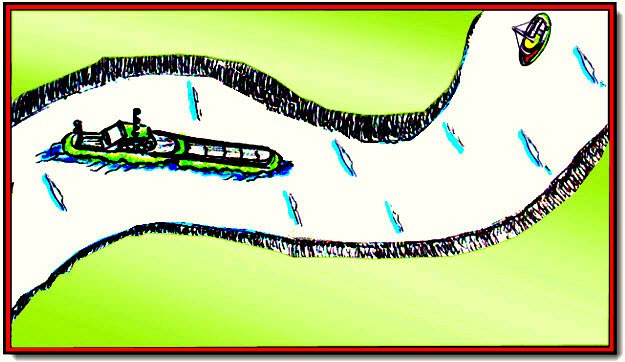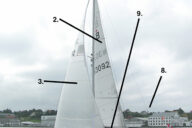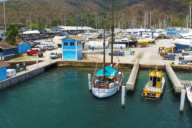Here’s another great sailing tip from our friend Capt. John of skippertips.com…
Imagine that you are sailing or powering down a long winding channel with lots of bends and turns. All of a sudden you hear a loud horn ahead of you that lasts more than five seconds. You scan ahead, but there are no other vessels in sight! What action should you take to avoid danger to your sailing crew and vessel?
Recognize This Warning Signal and Take Action
If you sail in inland or international waterways, you will often encounter points of land that stick out into the channel. These can block your view of any vessel or vessels around the bend.
Rule 34(e) in the Navigation Rules requires that you sound a specific signal of one prolonged blast (four to six second continuous blast) on the whistle to warn any other vessel that you are unable to see “around the bend” of your presence. (Skippertips members can download the Navigation Rules here => Navigation Rules).
Note that Navigation Rule 34(e) allows this signal to be sounded by either vessel. When we transited the Mississippi River one summer aboard our 135 foot coastal buoy tender “White Sumac“, it amazed our ship drivers just how snake-like this mighty western river could be.
Mile after mile of hairpin turns and bends would block your visibility as you approached the next loop in the river. It was like being stuck behind a massive, road-blocking semi-truck on the highway.
Add to that the frequent transit of tugs with barge-strings 1/2 mile or more in length, either being pushed ahead or towed “on the hip” (alongside). And you would not see any of these vessels until the last minute!
The sole source of knowing their location was often the piercing wail of their whistle as they sounded the “blind bend” signal. Radio was used too, of course, but radio traffic clogged the airways with so much vessel traffic. This sometimes made it next to impossible to use the radio to find out the intentions of another vessel. So signals were of paramount importance…
If we sounded our one prolonged blast first, we would listen for a reply from around the bend. And, if we heard an answer (this signal must be answered in kind with one prolonged blast), we knew we needed to “pull over” a bit to the side of the road until we sighted the tug. This gave us time to make an assessment of the situation and clear out of the way to give these mega-length vessels plenty of room to maneuver.
Make Signal Exchanges Crystal Clear
Remember that this signal always requires an answer by another vessel (if you initiate the signal) or by you (if the other vessel initiates the signal). This serves to let each vessel pinpoint the location of the other. Make prolonged signals prolonged.
Time and again, I have heard “lazy” boaters give a short toot of one or two seconds and be done with it. I believe that’s poor seamanship and it could lead to confusion. The Rules specify four to six seconds for a prolonged blast. Remember the #1 goal will be to alleviate confusion. If you toot a shortened blast, a vessel could misinterpret this as a signal of intent to pass (meeting, crossing, overtaking). Do the time. Four to six seconds means just that.
Does Radio Replace the Blind Bend Signal?
You may have heard of the Inland Rule that states that you may use the VHF radio instead of whistle signals to arrange for meeting, crossing or overtaking another vessel (this applies to Inland Waters of the US only; International Rules are silent on the use of the radio for passing agreements). Realize that this does not replace a whistle signal. Read this special Inland Rule now. Take note of the last sentence of the Rule.
Inland Rule 34(h)
A vessel that reaches agreement with another vessel in a head on, crossing, or overtaking situation, as for example, by using the radiotelephone as prescribed by the Vessel Bridge-to-Bridge Radiotelephone Act (85 Stat. 164; 33 U.S.C. 1201 et seq.), is not obliged to sound the whistle signals prescribed by this Rule, but may do so. If agreement is not reached, then whistle signals shall be exchanged in a timely manner and shall prevail.
Paragraph (h) of Inland Rule 34 references head on (meeting), crossing or overtaking situations. These are all situations of vessels being “in sight” of one another. That means you must be able to see the other vessel with your eyes. Not on radar. Not on AIS. And not obscured by fog, haze, squall, snow storm or an obstruction such as terrain that makes the bend ahead a “blind bend”.
Keep it simple; keep it safe. Sound the blind bend signal. What’s four to six seconds (the length of one prolonged blast) compared to the possibility of collision with a tug and barge or large ship?
You may use the radio in addition to the blind bend signal to transmit a “Sécurité” broadcast (special navigational safety warning). Initiate the broadcast on channel 16; then switch to another working frequency to provide details. This will warn those on the other side of a blind bend of your presence. Use this reference to see how to send a Sécurité broadcast => How to Send a Sécurité Broadcast
But don’t count on your transmission being heard. Indeed, the skipper of a tug and barge string could be talking to another vessel or maneuvering in a tricky part of the channel. Or, the radio signal could have been lost or blocked by terrain. Again, a simple prolonged blast of the horn could mean the difference between safety and risk. Choose safety. Every time.
~~~~~~~~~~~~~~~
Follow these easy sailing navigation tips to keep your sailing crew and small sailboat safe when sailing in areas with lots of twists and turns. Gain the peace-of-mind to know what lies ahead just around that bend ahead–wherever in the world you choose to sail or cruise!












